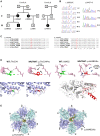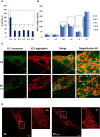Variants in ATP5F1B are associated with dominantly inherited dystonia
- PMID: 36860166
- PMCID: PMC10316767
- DOI: 10.1093/brain/awad068
Variants in ATP5F1B are associated with dominantly inherited dystonia
Abstract
ATP5F1B is a subunit of the mitochondrial ATP synthase or complex V of the mitochondrial respiratory chain. Pathogenic variants in nuclear genes encoding assembly factors or structural subunits are associated with complex V deficiency, typically characterized by autosomal recessive inheritance and multisystem phenotypes. Movement disorders have been described in a subset of cases carrying autosomal dominant variants in structural subunits genes ATP5F1A and ATP5MC3. Here, we report the identification of two different ATP5F1B missense variants (c.1000A>C; p.Thr334Pro and c.1445T>C; p.Val482Ala) segregating with early-onset isolated dystonia in two families, both with autosomal dominant mode of inheritance and incomplete penetrance. Functional studies in mutant fibroblasts revealed no decrease of ATP5F1B protein amount but severe reduction of complex V activity and impaired mitochondrial membrane potential, suggesting a dominant-negative effect. In conclusion, our study describes a new candidate gene associated with isolated dystonia and confirms that heterozygous variants in genes encoding subunits of the mitochondrial ATP synthase may cause autosomal dominant isolated dystonia with incomplete penetrance, likely through a dominant-negative mechanism.
Keywords: ATP5F1B; case report; dystonia; incomplete penetrance; mitochondrial ATP synthase.
© The Author(s) 2023. Published by Oxford University Press on behalf of the Guarantors of Brain.
Conflict of interest statement
The authors report no competing interests.
Figures



Similar articles
-
Variants in Mitochondrial ATP Synthase Cause Variable Neurologic Phenotypes.Ann Neurol. 2022 Feb;91(2):225-237. doi: 10.1002/ana.26293. Epub 2022 Jan 20. Ann Neurol. 2022. PMID: 34954817 Free PMC article.
-
A Novel Variant of ATP5MC3 Associated with Both Dystonia and Spastic Paraplegia.Mov Disord. 2022 Feb;37(2):375-383. doi: 10.1002/mds.28821. Epub 2021 Oct 11. Mov Disord. 2022. PMID: 34636445 Free PMC article.
-
Mutations in the mitochondrial complex I assembly factor NDUFAF6 cause isolated bilateral striatal necrosis and progressive dystonia in childhood.Mol Genet Metab. 2019 Mar;126(3):250-258. doi: 10.1016/j.ymgme.2019.01.001. Epub 2019 Jan 5. Mol Genet Metab. 2019. PMID: 30642748 Review.
-
EIF2AK2 Missense Variants Associated with Early Onset Generalized Dystonia.Ann Neurol. 2021 Mar;89(3):485-497. doi: 10.1002/ana.25973. Epub 2020 Dec 15. Ann Neurol. 2021. PMID: 33236446 Free PMC article.
-
AOPEP-related autosomal recessive dystonia: update on Zech-Boesch syndrome.J Med Genet. 2025 May 27;62(6):388-395. doi: 10.1136/jmg-2025-110656. J Med Genet. 2025. PMID: 40147878 Review.
Cited by
-
Mutations of the Electron Transport Chain Affect Lifespan and ROS Levels in C. elegans.Antioxidants (Basel). 2025 Jan 10;14(1):76. doi: 10.3390/antiox14010076. Antioxidants (Basel). 2025. PMID: 39857410 Free PMC article. Review.
-
Dominant negative ATP5F1A variants disrupt oxidative phosphorylation causing neurological disorders.medRxiv [Preprint]. 2025 Jul 8:2025.07.08.25330848. doi: 10.1101/2025.07.08.25330848. medRxiv. 2025. PMID: 40672495 Free PMC article. Preprint.
-
Variability of Clinical Phenotypes Caused by Isolated Defects of Mitochondrial ATP Synthase.Physiol Res. 2024 Aug 31;73(Suppl 1):S243-S278. doi: 10.33549/physiolres.935407. Epub 2024 Jul 17. Physiol Res. 2024. PMID: 39016153 Free PMC article.
-
Plasma acellular transcriptome contains Parkinson's disease signatures that can inform clinical diagnosis.medRxiv [Preprint]. 2024 Oct 18:2024.10.18.24315717. doi: 10.1101/2024.10.18.24315717. medRxiv. 2024. PMID: 39484251 Free PMC article. Preprint.
-
Dystonia and mitochondrial disease: the movement disorder connection revisited in 900 genetically diagnosed patients.J Neurol. 2024 Jul;271(7):4685-4692. doi: 10.1007/s00415-024-12447-5. Epub 2024 May 22. J Neurol. 2024. PMID: 38775934 Free PMC article. No abstract available.
References
-
- Schreglmann SR, Riederer F, Galovic M, et al. . Movement disorders in genetically confirmed mitochondrial disease and the putative role of the cerebellum: Mitochondrial movement disorders. Mov Disord. 2018;33:146–155. - PubMed
-
- Musumeci O, Oteri R, Toscano A. Spectrum of movement disorders in mitochondrial diseases. J Transl Genet Genomics. 2020;4:221–237.
-
- Fernandez-Vizarra E, Zeviani M. Mitochondrial disorders of the OXPHOS system. FEBS Lett. 2021;595:1062–1106. - PubMed
Publication types
MeSH terms
Substances
LinkOut - more resources
Full Text Sources
Medical
Molecular Biology Databases
Miscellaneous

